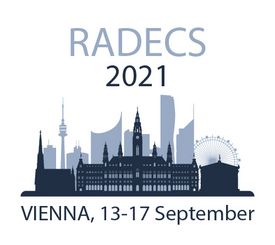E-1: Temperature Dependence of Radiation lnduced Attenuation of Aluminosilicate Optical Fiber
C. Campanella1, A. Morana1, A. Guttilla2, F. Mady3, M. Benabdesselam2, E. Marin1, A. Boukenter1, Y. Ouerdane1, S. Girard1
1 UJM, Laboratoire Hubert Curien, France
2 Université Côte d'Azur, Institut de Physique de Nice (INPHYNI), CNRS UMR 7010, France
We investigated in situ the temperature influence on the Radiation-lnduced Attenuation (RIA) of an Al-doped single-mode optical fiber in the Visible and Near-lnfraRed spectral regions (400 nm - 2 µm, room temperature to 300°C).
E-2: Optimization of the Radiation Response of Backup Optical Fiber Amplifiers for Space Missions
M. Aubry1,2,3,4, A. Morana1, A. Laurent2, L. Mescia3, J. Mekki4, N. Balcon4 , T. Robin2, E. Marin1, Y. Ouerdane1, A. Boukenter1, S. Girard1
1 UJM, Laboratoire Hubert Curien, France
2 iXblue Photonics, France
3 Politecnico di Bari, ltaly
4 CNES, France
We investigated how the photobleaching phenomenon could help in reducing the radiation impact on the performances of backup Erbium Doped Fiber Amplifiers (EDFAs) and Erbium-Ytterbium Doped Fiber Amplifiers (EYDFA) .
E-3: Impact of proton radiation on dark current of lnAs/GaSb type-2 superlattice longwave infrared photodetector
R. Alchaar1, C. Bataillon1, J. Perez1, O. Gilard1, P. Christol1
1 Université de Montpellier, France
Electrical characterizations of T2SL IR photodetectors under 60 MeV proton fluence up to 8x1011 cm-2 were performed. Dark current increases with increasing the DDD independently of the cut-off wavelength and the number of T2SL periods.
E-4: Dark Current Random Telegraph Signal in visible and SWIR Direct Cu-Cu bonding lnGaAs Image Sensor
V. Lalucaa1, L. Calvinhac1, C. Virmontois1
1 CNES, France
Irradiation effects are studied on commercial lnGaAs image sensors with hybrid direct Cu-Cu bonding. Performances, dark current and random telegraph signal are measured after 62MeV proton tests with different doses; and compared to existing models.
E-5: Probing Dark-Current Random-Telegraph-Signal in a Small Pitch Vertically Pinned Photodiodes CMOS Image Sensor after Proton Irradiation
A. Antonsanti1, C. Virmontois2, J. Lauenstein3, A. Le Roch1, V. Goiffon1
1 ISAE-SUPAERO, France
2 CNES, France
3 NASA GSFC, USA
Dark-Current Random Telegraph signal is studied after proton irradiation in new scale silicon micro-volumes using a commercial CMOS Image Sensor. State-of-the-art empirical trends and new scale effects are discussed.
PE-1: lonizing radiation effects in Silicon Photonics Modulators
M. Lalovic1, C. Scarcella1, A. Bulling1, M. Court1, S. Detraz1, L. Marcon1, L. Olantera1, T. Prousalidi1, U. Sandven1, C. Sigaud1, C. Soos1, J. Troska1
1 CERN, Switzerland
Two popular types of Silicon Photonics modulators have been exposed to ionizing radiation up to 4 MGy. Ring Modulators are shown to be the most tolerant, showing no degradation in performance up to these levels.
PE-2: ln-Situ Optical Characterization of Bulk Optical Glasses Under Proton Exposures
T. Allanche1, A. Morana1, P. Paillet2, O. Duhamel2, D. Lambert2, C. Hoehr3, C. Bélanger-Champagne3, M. Trinczek3, C. Muller1, Y. Ouerdane1, A. Boukenter1, S. Girard1
1 UJM, Laboratoire Hubert Curien, France
2 CEA, France
3 TRIUMF, Canada
We performed at TRIUMF in-situ radiation induced attenuation measurements caused by protons in bulk optical glasses and compared them with gamma-rays effect. We used GEANT4 calculations to compute the right deposited for each glass.














